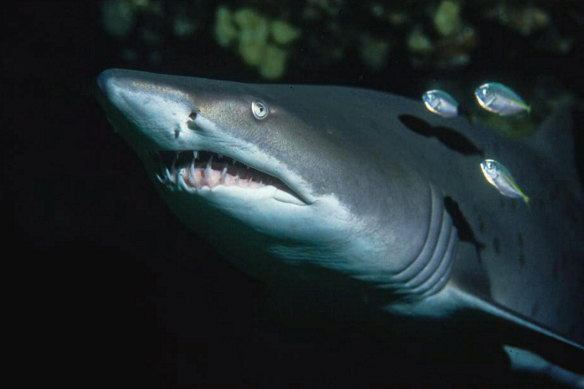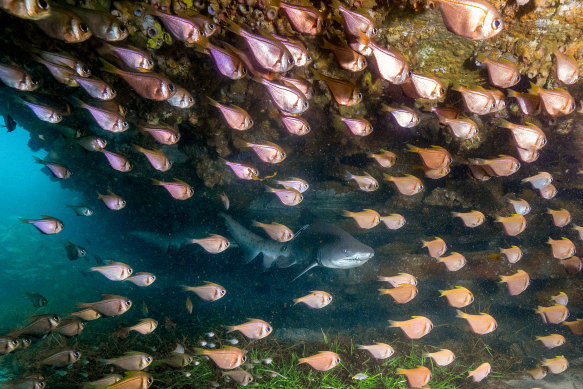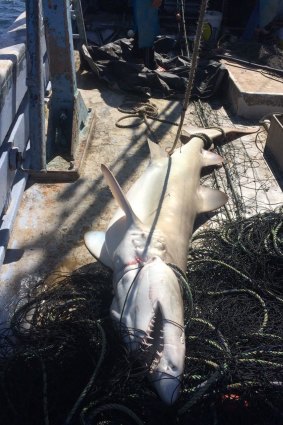This was published 11 months ago
‘Not doing what they should’: Shark nets a threat to critically endangered species
Shark nets installed at Sydney beaches every spring have caught 166 critically endangered grey nurse sharks since 2012, along with dolphins, turtles, rays and other non-target species.
Entanglements in the mesh nets killed 67 of the mostly harmless grey nurse sharks, putting pressure on a species estimated to number 2000 adults on the east coast, according to documents obtained by environment groups under freedom of information laws.
Despite the toll, the NSW government said on Wednesday it would continue with the shark nets for the 2024-25 summer, with modifications to protect turtles.

A grey nurse shark, a critically endangered species, at Magic Point off Sydney.Credit: Erik Schlögl
Lawrence Chlebeck, marine biologist and campaigner at Humane Society International, said a scientific analysis of the images released suggested 84 per cent of grey nurse sharks caught by the nets were females of breeding age.
He said there was no guarantee those released alive would survive.
“There is [also] a high chance that they can spontaneously abort pups if they are pregnant,” Chlebeck said. “Grey nurse sharks are particularly slow breeding … so that would be a huge impact on that population.”
Dr Phoebe Meagher from Taronga Conservation Society said grey nurse sharks had one or two pups every second year, compared with other shark species that can have up to six babies a year.

Two young grey nurse sharks, amid a school of fish off the headland at South Bondi.Credit: Duncan Heuer & Edwina Pickles
Government contractors clear the nets every 72 hours and their figures and photographs were obtained by Humane Society International and the Australian Marine Conservation Society under FOI laws.
The mesh nets are installed at 51 beaches from Newcastle to Wollongong, from September 1 to April 30 every year.
Under changes announced on Wednesday, the NSW government will remove shark nets one month earlier than usual to respond to increased turtle activity in April, increase the frequency of inspections during March to every second day, use drone surveillance to scout for turtles every other day, and trial the use of lights to deter turtles in February and March.
A deterrent rather than a barrier, the nets are 150 metres long and six metres above the sea floor, so sharks and other marine mammals can swim over, under and around them. They are positioned parallel to the beach 500 metres out to sea.
The nets are different to permanent shark nets in place at many harbour beaches, which enclose the swimming area and use materials that do not trap or harm marine animals.

A dead grey nurse shark, entangled in a mesh net off the coast of NSW. Image obtained from the NSW government under FOI.
A 2002 government report listed the mesh nets as a “key threatening process” for both grey nurse sharks and great white sharks, which are listed as vulnerable.
“They are stagnant death traps that are not doing what they should because they don’t reduce the risk of shark bite,” Chlebeck said.
The annual report of the shark management program for 2023-24 to be published on Thursday will reveal that 255 marine animals were caught in the nets last season. Of those, only 15 were target species (great white sharks, tiger sharks and bull sharks). Of the 240 non-target animals, 65 were threatened or protected species, including 29 turtles.
NSW Minister for Agriculture Tara Moriarty said the government’s $21.5 million shark management program was “evidence-based”, and the government had responded to community feedback.
“The NSW Government’s priority is the safety of beachgoers, at the same time we are committed to protecting our state’s marine life,” she said.
Other shark management measures include drone surveillance, listening stations to detect tagged sharks, training for surf clubs, and 305 SMART drumlines from Tweed to Bega, which aim to capture sharks unharmed and relocate them further offshore.
The mesh nets have been used on NSW beaches since 1937. A 1997 peer-reviewed paper in Ocean & Coastal Management found the meshing programs in Australia and overseas reduced the rate of human-shark interactions by up to 90 per cent.
However, a 2019 study of the nets from the University of Wollongong in People and Nature found there was no difference in risk between a netted and non-netted beach, and any improvements in public safety came from surf lifesaving patrols.
Figures from the Australian Shark Incident Database, maintained by Taronga Conservation Society Australia, suggest there have been more than 100 unprovoked shark bites in NSW over the past 20 years. The majority were great whites, followed by wobbegongs and bull sharks. Only one was a grey nurse – an incident at Shelly Beach near Manly, a popular swimming and snorkelling area, in 2019.
Meagher said great white and bull sharks were a threat to humans, but wobbegongs were too small to do much damage and mostly bit people who accidentally stepped on the bottom-dwellers.
Bondi resident Duncan Heuer, co-founder of the Saving Norman campaign to end mesh nets, said grey nurse sharks were very docile, especially in daylight. Local divers discovered an aggregation site of the protected species during the pandemic.
A number of councils are opposed to shark nets, including Waverley, Northern Beaches, Central Coast and Wollongong. The government flagged it would consider local decision-making on the removal or use of nets in the future.
Get to the heart of what’s happening with climate change and the environment. Our fortnightly Environment newsletter brings you the news, the issues and the solutions. Sign up here.